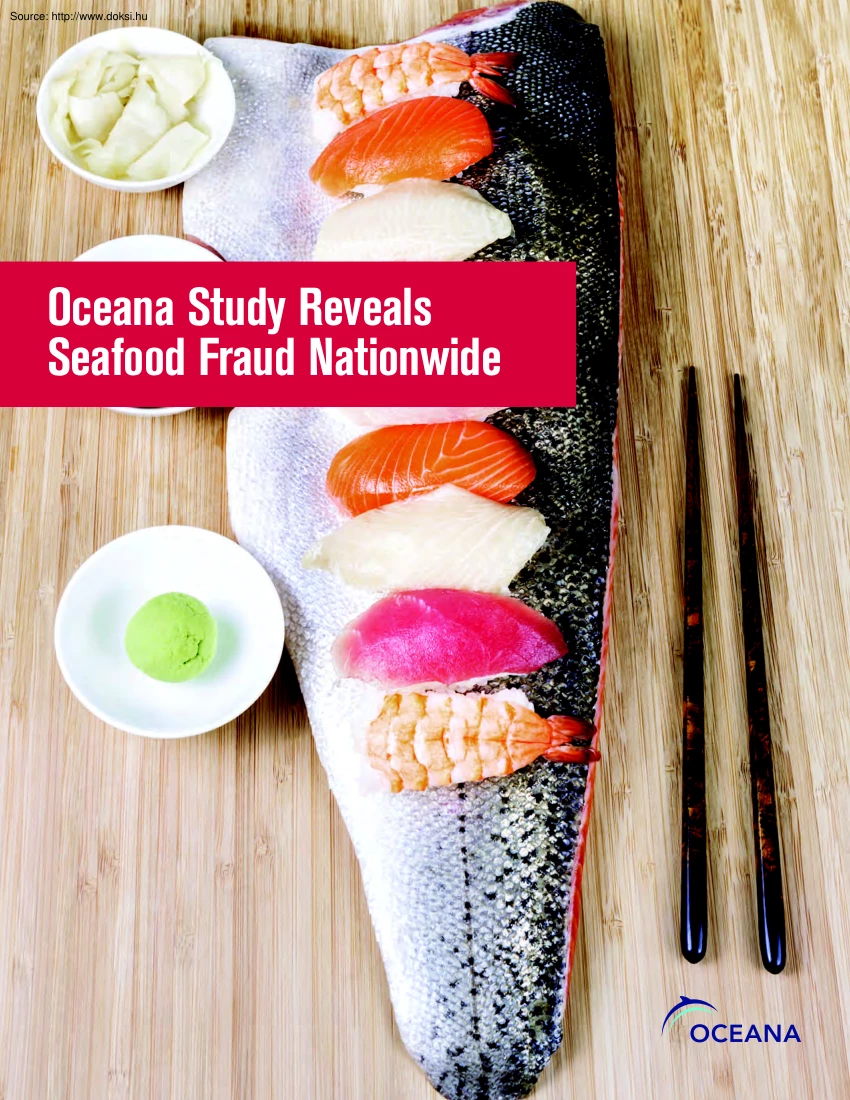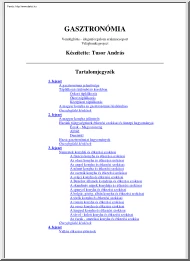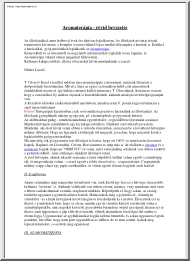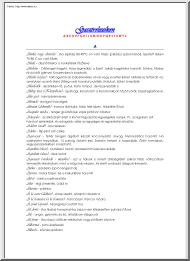Datasheet
Year, pagecount:2013, 6 page(s)
Language:English
Downloads:5
Uploaded:December 14, 2013
Size:798 KB
Institution:
-
Comments:
Attachment:-
Download in PDF:Please log in!
Comments
No comments yet. You can be the first!Most popular documents in this category
Content extract
Oceana Study Reveals Seafood Fraud Nationwide Seafood is a popular and healthy food choice for many Americans, with the United States only trailing China, as the second largest seafood consumer worldwide. The American Heart Association, as well as new dietary guidelines from the U.S government, both recommend eating eight ounces of seafood, or two seafood meals, a week. However, seafood consumers are often given insufficient, confusing or misleading information about the fish they purchase. Seafood is a global commodity and is one of the most commonly traded food items in the world. Today, more than 90 percent of the seafood consumed in the US is imported, and less than 1 percent is inspected by the government specifically for fraud. With more than 1,700 different species of seafood from all over the world available for sale in the U.S, it is unrealistic to expect the American consumer to be able to independently and accurately determine what they are actually eating. Despite
growing concern about where our food comes from, consumers are frequently served a completely different type of fish than the one they paid for. As Oceana’s nationwide study and others demonstrate, seafood may be mislabeled as often as 26 to 87 percent of the time for commonly swapped fish such as grouper, cod and snapper, disguising fish that are less desirable, cheaper or more readily available. While seafood fraud encompasses any illegal activity that misrepresents the fish you purchase, including mislabeling and falsifying documents, to adding too much ice to packaging, Oceana’s focus is on seafood substitution. From 2010 to 2012, Oceana conducted one of the largest seafood fraud investigations in the world to date, collecting more than 1,200 samples from 674 retail outlets in 21 states to determine if they were honestly labeled. DNA testing found that one-third, or 33 percent, of the 1,215 seafood samples were mislabeled, according to U.S Food and Drug Administration (FDA)
guidelines. “Oceana found one in three seafood samples mislabeled nationwide.” While Oceana’s study was restricted to retail outlets, including restaurants, sushi venues and grocery stores, it is unknown exactly where in the supply chain seafood fraud actually takes place. With an increasingly complex and obscure seafood supply chain, it is difficult to identify if fraud is occurring on the boat, during processing, at the retail counter or somewhere along the way. Oceana’s testing results demonstrate that seafood fraud not only hurts our wallets, but also honest fishermen and businesses along the supply chain. These fraudulent activities also carry potentially serious concerns for our health as well as the wellbeing of our oceans and vulnerable fish populations. SEATTLE, WASHINGTON 18% Mislabeled Every snapper sample was mislabeled PORTLAND, OREGON 21% Mislabeled More than 25% of the retail outlets visited sold mislabeled fish NORTHERN CALIFORNIA 38% Mislabeled
Rockfish was substituted for snapper 34 different times SOUTHERN CALIFORNIA 52% Mislabeled Highest mislabeling rate nationwide, 20% higher than national average DENVER, COLORADO 36% Mislabeled Imperiled Gulf grouper was sold as more sustainable black grouper KANSAS CITY, MISSOURI / KANSAS 35% Mislabeled As with the rest of the country, white tuna was found to be escolar Overfished Atlantic cod was sold as orange roughy, another unsustainable choice Additional samples were also collected in Maryland, Minnesota, New Jersey, New Mexico, Virginia, Wisconsin and West Virginia. AUSTIN / HOUSTON, TEXAS 49% Mislabeled 48% of the retail outlets visited sold mislabeled seafood In Austin, every sushi sample was mislabeled CHICAGO, ILLINOIS BOSTON, MASSACHUSETTS 32% Mislabeled Three fish that the FDA does not recognize as commonly sold in the U.S were substituted for more familiar species like cod, tuna and red snapper Every sushi venue sold at least one mislabeled fish 18%
Mislabeled (48% including testing by The Boston Globe) PENNSYLVANIA 56% Mislabeled Nearly 50% of the grocery stores visited sold mislabeled fish Tilapia was substituted for red snapper, following a national trend NEW YORK, NEW YORK 39% Mislabeled Tilefish, a fish on the FDA’s DO NOT EAT list for sensitive groups due to high mercury, was sold as halibut and red snapper in a small market Every sushi venue sold mislabeled fish WASHINGTON, D.C 26% Mislabeled Every snapper sample was mislabeled Every sushi venue sold mislabeled fish ATLANTA, GEORGIA SOUTH FLORIDA 38% Mislabeled King mackerel, a fish on the FDA’s DO NOT EAT list for sensitive groups due to high mercury, was sold as grouper in a grocery store 25% Mislabeled One of the few cities that sold a true red snapper Commonly Mislabeled Fish KEY RESULTS • Mislabeling was found in 27 of the 46 fish types tested (59%). What You Bought What You Got • Salmon, snapper, cod, tuna, sole, halibut and grouper were the
top collected fish types. Chilean seabass Antarctic toothfish Alaskan/Pacific cod • Snapper (87%) and tuna (59%) were the most commonly mislabeled fish types. Pangasius (Asian “catfish”), Atlantic cod, threadfin slickhead, tilapia Atlantic cod • Only seven of the 120 red snapper samples were honestly labeled. Pacific cod, white hake grouper Pangasius (Asian “catfish”), king mackerel, whitefin weakfish Alaskan/Pacific halibut Atlantic halibut, blueline tilefish salmon (wild, king and sockeye) farmed Atlantic salmon sea bass Antarctic toothfish, Patagonian toothfish snapper giltheaded seabream, madai, tilapia, Pacific ocean perch, widow rockfish, yellowtail rockfish red snapper Caribbean red snapper, crimson snapper, spotted rose snapper, Pacific ocean perch, yellowtail rockfish, giltheaded seabream, madai, tilapia, white bass lemon sole blackback flounder, summer flounder, flathead sole, yellowfin sole white tuna escolar • Between one-fifth to more
than one-third of the halibut, grouper, cod and Chilean seabass samples were mislabeled. • 44% of all the grocery stores, restaurants and sushi venues visited sold mislabeled seafood. • 84% of the white tuna samples were actually escolar, a species that can cause serious digestive issues for some individuals who eat more than a few ounces. Mislabeling by Retail Outlet 800 700 18% mislabeled 600 Number of Fish correctly labeled 500 400 300 38% 200 74% 100 0 Grocery Stores Restaurants Sushi Venues RECOMMENDATIONS Despite frequent coverage in the press, as well as state and federal enforcement on the issue, seafood fraud remains a persistent problem in the United States. As Oceana’s study suggests, seafood fraud is a nationwide problem that requires federal attention to ensure that the seafood sold in the U.S is safe, legal and honestly labeled Seafood traceability, or tracking fish from boat to plate, would significantly reduce seafood fraud, while providing
consumers with more information about the seafood they are purchasing, including the exact species, where, when and how it was caught, if it was farmed or previously frozen and if any additives were used during processing. While U.S fishermen already provide much of this information at the dock, little to none of it follows the fish throughout the supply chain. By requiring full traceability of all seafood sold in the U.S, our government can protect consumers from seafood fraud, while keeping illegally caught fish out of our market. The federal government needs to increase seafood inspections and testing, improve documentation and verification and require seafood traceability so that consumers can make more informed decisions about their purchases. WHAT CONSUMERS CAN DO • Ask questions. Consumers should ask more questions, including what kind of fish it is, if it is wild or farm raised, and where, when and how it was caught. • Check the price. If the price is too good to be
true, it probably is, and you are likely purchasing a completely different species than what is on the label. • Purchase the whole fish. When possible, consumers can purchase the whole fish, which makes it more difficult to swap one species for another. For Oceana’s full national seafood fraud report, please visit oceana.org/fraudnationwide
growing concern about where our food comes from, consumers are frequently served a completely different type of fish than the one they paid for. As Oceana’s nationwide study and others demonstrate, seafood may be mislabeled as often as 26 to 87 percent of the time for commonly swapped fish such as grouper, cod and snapper, disguising fish that are less desirable, cheaper or more readily available. While seafood fraud encompasses any illegal activity that misrepresents the fish you purchase, including mislabeling and falsifying documents, to adding too much ice to packaging, Oceana’s focus is on seafood substitution. From 2010 to 2012, Oceana conducted one of the largest seafood fraud investigations in the world to date, collecting more than 1,200 samples from 674 retail outlets in 21 states to determine if they were honestly labeled. DNA testing found that one-third, or 33 percent, of the 1,215 seafood samples were mislabeled, according to U.S Food and Drug Administration (FDA)
guidelines. “Oceana found one in three seafood samples mislabeled nationwide.” While Oceana’s study was restricted to retail outlets, including restaurants, sushi venues and grocery stores, it is unknown exactly where in the supply chain seafood fraud actually takes place. With an increasingly complex and obscure seafood supply chain, it is difficult to identify if fraud is occurring on the boat, during processing, at the retail counter or somewhere along the way. Oceana’s testing results demonstrate that seafood fraud not only hurts our wallets, but also honest fishermen and businesses along the supply chain. These fraudulent activities also carry potentially serious concerns for our health as well as the wellbeing of our oceans and vulnerable fish populations. SEATTLE, WASHINGTON 18% Mislabeled Every snapper sample was mislabeled PORTLAND, OREGON 21% Mislabeled More than 25% of the retail outlets visited sold mislabeled fish NORTHERN CALIFORNIA 38% Mislabeled
Rockfish was substituted for snapper 34 different times SOUTHERN CALIFORNIA 52% Mislabeled Highest mislabeling rate nationwide, 20% higher than national average DENVER, COLORADO 36% Mislabeled Imperiled Gulf grouper was sold as more sustainable black grouper KANSAS CITY, MISSOURI / KANSAS 35% Mislabeled As with the rest of the country, white tuna was found to be escolar Overfished Atlantic cod was sold as orange roughy, another unsustainable choice Additional samples were also collected in Maryland, Minnesota, New Jersey, New Mexico, Virginia, Wisconsin and West Virginia. AUSTIN / HOUSTON, TEXAS 49% Mislabeled 48% of the retail outlets visited sold mislabeled seafood In Austin, every sushi sample was mislabeled CHICAGO, ILLINOIS BOSTON, MASSACHUSETTS 32% Mislabeled Three fish that the FDA does not recognize as commonly sold in the U.S were substituted for more familiar species like cod, tuna and red snapper Every sushi venue sold at least one mislabeled fish 18%
Mislabeled (48% including testing by The Boston Globe) PENNSYLVANIA 56% Mislabeled Nearly 50% of the grocery stores visited sold mislabeled fish Tilapia was substituted for red snapper, following a national trend NEW YORK, NEW YORK 39% Mislabeled Tilefish, a fish on the FDA’s DO NOT EAT list for sensitive groups due to high mercury, was sold as halibut and red snapper in a small market Every sushi venue sold mislabeled fish WASHINGTON, D.C 26% Mislabeled Every snapper sample was mislabeled Every sushi venue sold mislabeled fish ATLANTA, GEORGIA SOUTH FLORIDA 38% Mislabeled King mackerel, a fish on the FDA’s DO NOT EAT list for sensitive groups due to high mercury, was sold as grouper in a grocery store 25% Mislabeled One of the few cities that sold a true red snapper Commonly Mislabeled Fish KEY RESULTS • Mislabeling was found in 27 of the 46 fish types tested (59%). What You Bought What You Got • Salmon, snapper, cod, tuna, sole, halibut and grouper were the
top collected fish types. Chilean seabass Antarctic toothfish Alaskan/Pacific cod • Snapper (87%) and tuna (59%) were the most commonly mislabeled fish types. Pangasius (Asian “catfish”), Atlantic cod, threadfin slickhead, tilapia Atlantic cod • Only seven of the 120 red snapper samples were honestly labeled. Pacific cod, white hake grouper Pangasius (Asian “catfish”), king mackerel, whitefin weakfish Alaskan/Pacific halibut Atlantic halibut, blueline tilefish salmon (wild, king and sockeye) farmed Atlantic salmon sea bass Antarctic toothfish, Patagonian toothfish snapper giltheaded seabream, madai, tilapia, Pacific ocean perch, widow rockfish, yellowtail rockfish red snapper Caribbean red snapper, crimson snapper, spotted rose snapper, Pacific ocean perch, yellowtail rockfish, giltheaded seabream, madai, tilapia, white bass lemon sole blackback flounder, summer flounder, flathead sole, yellowfin sole white tuna escolar • Between one-fifth to more
than one-third of the halibut, grouper, cod and Chilean seabass samples were mislabeled. • 44% of all the grocery stores, restaurants and sushi venues visited sold mislabeled seafood. • 84% of the white tuna samples were actually escolar, a species that can cause serious digestive issues for some individuals who eat more than a few ounces. Mislabeling by Retail Outlet 800 700 18% mislabeled 600 Number of Fish correctly labeled 500 400 300 38% 200 74% 100 0 Grocery Stores Restaurants Sushi Venues RECOMMENDATIONS Despite frequent coverage in the press, as well as state and federal enforcement on the issue, seafood fraud remains a persistent problem in the United States. As Oceana’s study suggests, seafood fraud is a nationwide problem that requires federal attention to ensure that the seafood sold in the U.S is safe, legal and honestly labeled Seafood traceability, or tracking fish from boat to plate, would significantly reduce seafood fraud, while providing
consumers with more information about the seafood they are purchasing, including the exact species, where, when and how it was caught, if it was farmed or previously frozen and if any additives were used during processing. While U.S fishermen already provide much of this information at the dock, little to none of it follows the fish throughout the supply chain. By requiring full traceability of all seafood sold in the U.S, our government can protect consumers from seafood fraud, while keeping illegally caught fish out of our market. The federal government needs to increase seafood inspections and testing, improve documentation and verification and require seafood traceability so that consumers can make more informed decisions about their purchases. WHAT CONSUMERS CAN DO • Ask questions. Consumers should ask more questions, including what kind of fish it is, if it is wild or farm raised, and where, when and how it was caught. • Check the price. If the price is too good to be
true, it probably is, and you are likely purchasing a completely different species than what is on the label. • Purchase the whole fish. When possible, consumers can purchase the whole fish, which makes it more difficult to swap one species for another. For Oceana’s full national seafood fraud report, please visit oceana.org/fraudnationwide





